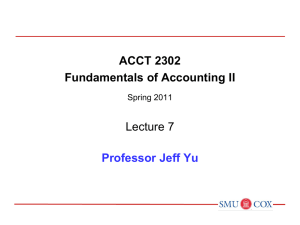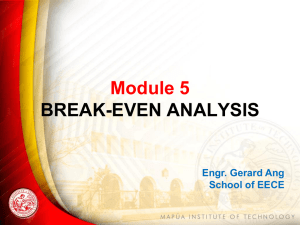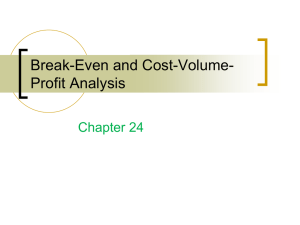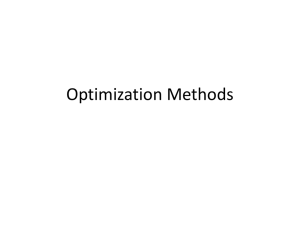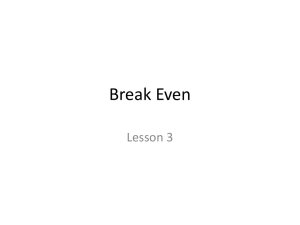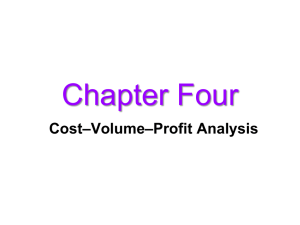AFM102_2013_Feb6_BeforeClass
advertisement
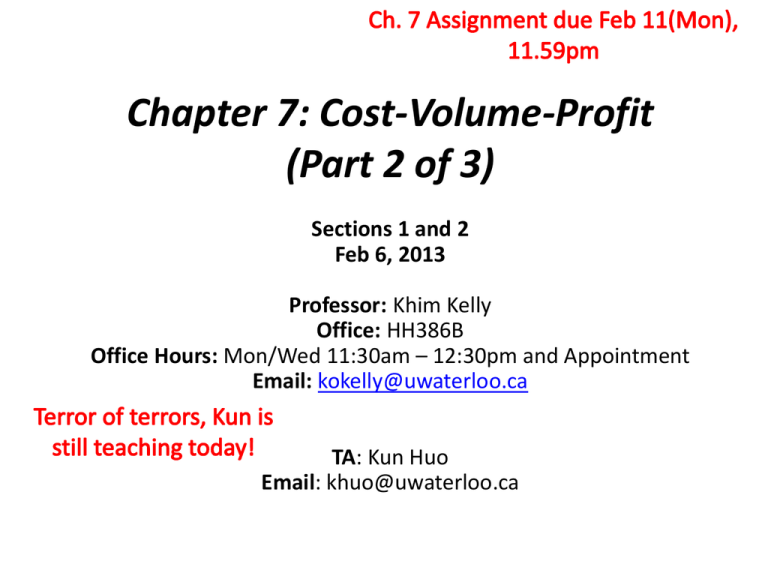
Chapter 7: Cost-Volume-Profit (Part 2 of 3) Sections 1 and 2 Feb 6, 2013 Professor: Khim Kelly Office: HH386B Office Hours: Mon/Wed 11:30am – 12:30pm and Appointment Email: kokelly@uwaterloo.ca TA: Kun Huo Email: khuo@uwaterloo.ca 6 Feb 2013 Overview • Last lecture … – Basics of CVP – CM Ratio – Break-even Analysis • Major topics for today… – More break even analysis – Margin of safety analysis – Target operating profit analysis 2 Last lecture: Total Expenses … $ Total Expenses Variable Expenses Fixed Expenses Activity Last lecture: CVP Relationships in Graphical Form Total Sales Revenue $ Total Expenses Activity Last lecture: Contribution Margin Ratio • CM ratio … – Contribution margin (Sales less Variable Expenses) as a percentage of total sales (say 40%) – For every $1 of sales increase, CM will increase by $0.40 – The effect on operating income of any dollar change in total sales can be computed by applying the CM ratio to the dollar change CM Ratio = Total CM Total Sales = Total CM per unit Total Sales per unit Change in op income = Change in sales x CM Ratio Last lecture: CM and Break-even Point • Break-even point is … – The level of sales at which profit = 0 – Also known as the point where total sales = total expenses or where total contribution margin = fixed expenses Break-even point: Profit = Sales – Variable Costs – Fixed Costs = $0 CM – Fixed Cost = $0 Break-Even Analysis • The Equation Method Profits = Sales – Variable Expenses – Fixed Expenses 0 = Sale price*Break-even units – Variable cost per unit*Break-even units – Fixed Expenses • The Contribution Margin Method Break-even units = Fixed Expenses Unit CM Break-even $ = Fixed Expenses CM Ratio It is Clicker Time!! Feel Free to Work Together on Clicker Questions Clicker Question #1 A company increased the selling price for its product from $1.00 to $1.10 a unit when total fixed expenses increased from $400,000 to $480,000 and the variable expense per unit remained unchanged at $0.50. How would these changes affect the break-even point? A) The break-even point in units would increase B) The break-even point in units would decrease C) The break-even point in units would remain unchanged D) The break-even point is evenly breakable!!! E) Dillon’s garage band is making a ‘killing’! 9 Margin of Safety • Margin of Safety is … – The excess of budgeted (or actual) sales over the breakeven volume of sales – How much can sales drop before losses occur? Margin of Safety $ = Total Sales $ – Break-Even Sales $ Margin of Safety % = Margin of Safety $ Total Sales $ It is Clicker Time!! Feel Free to Work Together on Clicker Questions Clicker Question #2 The margin of safety is equal to which of the following formulas? A) B) C) D) E) Sales - Operating income Sales - (Variable expenses/Contribution margin) Formula 1 Sales - (Fixed expenses/Contribution margin ratio). Sales – Fixed expenses. 12 Faddish Products (P7-29) Novelties Inc. makes and sells ‘faddish’ products to the preteen market. A new product has come to market that the company wants to make and sell. Enough capacity exists in the company’s plant to produce 30,000 units each month. Variable costs to manufacture and sell one unit would be $1.60 and fixed costs would total $40,000 per month. Demand should exceed 30,000 units. Additional capacity can be rented from another company at a fixed cost of $2,000 per month. Variable costs at the rent facility would be $1.75 per unit. The product – regardless of where it is made – will sell for $2.50. 13 Faddish Products (P7-29) Q1: Compute the monthly break-even point for the new product in units AND in total dollar sales. 14 Faddish Products (P7-29) First, Calculate the Contribution Margin per unit: 15 Faddish Products (P7-29) Second, compare CM on first 30,000 units to total fixed expenses on first 30,000 units: Do we need extra capacity? 16 Faddish Products (P7-29) Third, calculate the additional sales required to recover loss of _______ on the first 30,000 units and additional fixed cost of ______ , so the break even formula is: 17 Faddish Products (P7-29) Q2: How many units must be sold each month to make monthly operating income $9,000? (i.e., target operating profit analysis) 18 Faddish Products (P7-29) Additional Production = Desired Operating Income Unit Contribution Margin Therefore the company must sell an additional _____ units beyond their break-even point to earn a profit of $9,000. This means _____ units must be sold to earn $9,000. 19 Faddish Products (P7-29) Q3: If the sales manager receives a bonus of $0.15 for each unit sold in excess of the break-even point, how many units must be sold each month to earn a return of 25% on the monthly investment in fixed costs? Note: If $0.15 is paid for each unit sold in excess of the break-even point, then the CM on units beyond 50,000 units drops from $0.75 to _____ (Because the bonus is EXTRA variable cost) per unit Also, desired monthly profit is: 25% * ($40,000 + $2,000) = $10,500 20 Faddish Products (P7-29) Additional Production = Desired Operating Income Unit Contribution Margin Therefore the company must sell an additional ______ units beyond their break-even point to earn a profit of $10,500. This means _____ units must be sold to earn $10,500. 21 Important Points • Target operating profit analysis is just another form of break-even analysis – In break-even, you set target profit to 0 – In target profit, you set target profit to a specific positive number • Margin of safety analysis is also another form of target profit analysis – The margin of safety is the amount of sales needed to achieve a specific profit target Summary • Major topics for today… – More break-even analysis – Margin of safety analysis – Target operating profit analysis • Next lecture … – Cost Structure Choice and Leverage – Indifference analysis – Multi-product Settings


